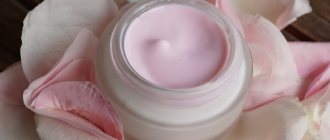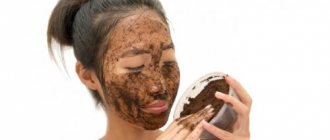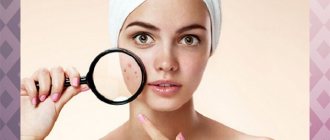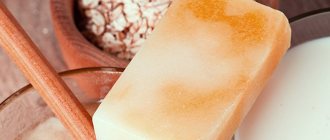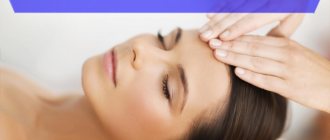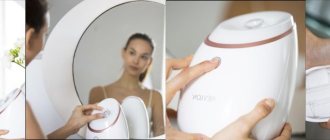Does sensitive epidermis need cleaning: pros and cons
Some people do not even suspect that the discomfort and symptoms that accompany daily skin care procedures are not a manifestation of any dermatological diseases, but simply indicate increased tissue sensitivity. If the epidermis reacts violently to stress, hard water, poor-quality cosmetics, weather conditions, disruption of sleep and rest patterns, then a properly selected peeling or scrub for sensitive skin will quickly reveal its positive properties.
The following factors indicate the benefits of cleaning:
- as a result of a mild but intense effect, metabolic processes are launched, which gradually restore the protective forces of the epidermis. It turns out that the removal of keratinized cells leads to the activation of the regenerative properties of tissues and an increase in skin density.
- Even the most gentle peelings have pronounced bactericidal properties. Often, the increased reactivity of the epidermis is associated precisely with the parasitism of pathogenic bacteria on the surface of the face. It is useless to fight such colonies with water and mild cosmetic products.
- Delicate scrubs completely remove from the skin the remnants of decorative cosmetics, which become clogged in folds and pores, entering into chemical reactions with skin secretions or sweat, causing the development of inflammatory processes.
- timely application of gommage, scrub or peeling for sensitive skin will accelerate the removal of toxins and free radicals. These chemical compounds tend to accumulate in the thickness of tissues, adversely affecting metabolic processes in cells and reducing the level of their protection.
- There is a special type of mites that parasitize human skin, attaching themselves to the mouths of hair follicles and causing the formation of foci of inflammation. Such manifestations cannot be eliminated with daily care; special therapeutic procedures are necessary. For this case, specialists have developed special gentle peelings that can be used even for those conditions that are most often a contraindication to cosmetic interventions.
- even sensitive facial skin needs to control the thickness of the stratum corneum. Refusal to carry out cleansing manipulations can lead to the appearance of a dense crust, which reduces tissue permeability, leading to impaired access of oxygen, and the appearance of problem areas.
Risk factors associated with peeling for sensitive skin:
- Even the most delicate scrubs and gentle peels are highly intense. Abuse of manipulation can lead to thinning of the epidermis and increased severity of aesthetic and physiological problems.
- peeling for sensitive skin is carried out only after preliminary preparation and testing for tolerance of the ingredients. Neglect of safety precautions threatens violent allergic reactions and even the appearance of permanent defects.
- There are not many procedures for caring for reactive epidermis. Incorrectly selected manipulation can worsen the condition of any skin type, and in the case of sensitive epidermis, the formation of combination facial skin is possible, the care of which is considered even more problematic.
- Chemical compositions for sensitive facial skin are quite difficult to choose. Acids of even the lowest concentration can unexpectedly cause chemical burns.
Types of home peelings
You can carry out mechanical and chemical peeling yourself.
Mechanical peeling is cleansing the facial skin using natural scrubs. For dry skin, during mechanical peeling, the composition should not contain large abrasive particles or absorbent substances. Fruit acids, semolina, oatmeal, and coffee grounds are considered safe.
Chemical peeling is the removal of dead skin cells using acids.
Chemical peeling is:
- surface;
- average;
- deep.
It is safest to use a superficial peel at home. The composition of which is prepared on the basis of suitable means at hand and natural fruit acids. The following types of surface peeling are practiced: fruit, milk, almond, glycolic, salicylic. In such peeling compositions the concentration of acids is insignificant, so they do not injure the skin.
What to look for when choosing a peel for sensitive skin
Considering the fact that a peeling or scrub for sensitive skin should be as gentle as possible, first of all, pay attention to the composition of the drug used, the contact medium and the type of manipulation.
Features of chemical peels
- To carry out acid peels, the lowest possible concentrations of reagents are used as a base. If after the first manipulations the benefit is obvious and there are no side effects, then the concentration can be gradually increased until the usual levels are achieved.
- Hard peeling is not suitable for sensitive skin. It is forbidden to rub the components into the skin with force! It is only allowed to apply the composition to the surface of the face in an even layer (multiple layers are also not encouraged) using special tools.
- The time for which a chemical peel is applied for sensitive skin should be reduced compared to standard rates.
- If you decide to carry out peptide or enzyme cleansing, then you should not use fruit acids as a strengthening component. It is better to use delicate scrubs before the procedure, which will increase tissue permeability and stimulate tissue circulation.
- The use of aggressive acids and medicinal components (hydrogen peroxide, calcium chloride, aspirin) is unacceptable!
- Chemical reagents are applied only to the surface of the epidermis that has been previously moistened and protected with a special nutrient medium.
- Medium and deep chemical cleansing can be carried out only according to strict indications, with the permission of a doctor and after a preparatory stage that reduces cell reactivity.
Features of mechanical peelings
- Diamond facial cleansing (with the most gentle attachments), homemade film masks and delicate scrubs made from natural products are the only acceptable means of mechanical action on sensitive facial skin.
- If the integrity of the skin is damaged during cleaning, it is necessary to give the wound maximum care. It must be processed and disinfected. Often, due to oversight, a secondary infection occurs, which leads to long-term rehabilitation.
- Before and after mechanical treatment of tissues, the face must be treated with a moisturizing serum or cream.
- It is recommended to prepare a scrub for sensitive skin yourself. Industrial products contain too many preservatives and dyes that can aggravate the condition of the epidermis.
- Manual mechanical local cleaning of problem areas is acceptable, but in this case increased attention must be paid to sterility.
Features of hardware procedures
- According to modern cosmetologists, hardware cleansing today is one of the most optimal options for caring for sensitive skin. The ability to carry out targeted treatment, control the intensity of the procedure and the depth of cleaning significantly reduces the risks of complications and side effects.
- Before performing any hardware manipulation, a complete examination of the skin must be carried out. The specialist determines the type of problem, the thickness of the stratum corneum and epidermis, and only after that makes a decision on the possibility of conducting a session.
- Hardware peeling for sensitive skin is rarely carried out in standard courses. In this case, more time is required for tissue restoration; the number of procedures is noticeably reduced compared to usual indicators.
The listed rules and recommendations apply not only to salon, but also to home manipulations. Ideally, before starting any therapeutic courses, it is necessary to conduct a full examination of the tissues and obtain advice from an experienced cosmetologist.
Carrying out at home
Peels recommended for home use are less effective, but safer than salon peels. You can try different formulations and home recipes, but at the same time record how the skin reacts to them. She doesn't need additional dryness and irritation. Therefore, try to choose products without hard abrasive particles and with moisturizing ingredients - peelings and gommages.
Store-bought drugs
The most popular products for home use:
- Aquanti hyaluronic peeling roller from the Novosvit company . Recommended for all types of dermis, including dry ones, as it moisturizes it due to the content of hyaluronic acid. Restores the water-lipid balance of the epidermis and does not cause a feeling of tightness. Evens out skin texture, exfoliates, heals and softens the skin. Other components in this peeling include collagen, apple, kiwi, grapefruit and orange extracts. The product has a delicate texture. Apply to dry, pre-cleansed dermis with movements reminiscent of a light massage. The exceptions are the areas around the eyes and lips. After the lumps roll off, the peeling is washed off with water. At the end of the procedure, you can use a moisturizer. You can buy a 100-ml bottle at a price of 100 to 200 rubles.
- Gentle peeling from Natura Siberica called Instant Skin Renewal . In parallel with exfoliation of the dermis, it enhances its protective capabilities. Makes the epidermis smoother and its shade more even. The product is designed for women with dry and normal skin types. AHA acids, meadowsweet, Manchurian aralia and other components are responsible for tone, firmness, elasticity and renewal of the skin. Peeling is a Natural&Organic certified product. It is easy to use: massage a damp face with a small amount of product squeezed out of a 150 ml tube. After this, the drug must be washed off. The cost of an organic product is from 180 to 300 rubles.
- The ALPHA-BETA line of the Israeli company Holy Land consists of several professional peelings and also includes preparations that can be used at home. They contain various acids and retinol. For example, PREPPING LOTION peeling lotion additionally contains extracts of orange, lemon, green tea and other components. Evens out the texture and shade of the dermis and has a slight lifting effect. You need to wipe your face, neck and décolleté with lotion 2-3 times a week. A 250 ml bottle costs about 3,000 rubles. The line also includes RESTORING SOAP peeling soap, which maintains the water balance of the dermis, makes the skin smoother and more uniform, and reduces pores. In addition to the main ingredients (acids and retinol), it contains extracts of chamomile, maple, and horsetail. Available in liquid form, bottle volume - 125 ml, cost - about 1500 rubles. Directions for use: spread over damp skin, massage with light circular movements, rinse. The manufacturer assures that the product can be used daily.
- Achromin, renewing peeling with AHA acids for dry and sensitive skin . Suitable for face, neck, décolleté. Refreshes and improves the skin, smoothing out unevenness. Contains glycolic, lactic and citric acids, as well as softening and moisturizing components - allantoin and panthenol, which promote the regeneration of the epidermis. Peeling can be used no more than 2 times a week, preferably in the evening. There are no age restrictions. Price: 350–570 rubles per 50 ml jar. The product is distributed over previously cleansed skin, taking into account the massage lines. An exception should be the area around the eyes. After 5–10 minutes, the peeling is washed off with warm water using a cotton pad, the face is blotted with a towel and a moisturizer is applied.
- Soft facial scrub Clean Line . Contains raspberry juice and cranberry seeds. Suitable for dry and sensitive skin. Gently removes dead cells of the dermis, improves complexion, tones and accelerates skin renewal. The scrub is applied to the neck and face, after moisturizing them. The area around the eyes does not need to be treated. After a light massage, the product is washed off with warm water. A 50 ml tube costs about 70 rubles.
Attention! When doing the procedure at home, many women use professional products designed for experienced and competent cosmetologists. For example, Lingonberry Peeling from NEW LINE PROFESSIONAL. However, consider whether such amateur activity is justified, as it increases the risk of complications and side effects.
Folk remedies
These peels for dry skin are the safest and most gentle. After all, they contain fruits, berries, vegetables, cereals, and dairy products. Here are some popular options for at-home exfoliators:
- Oatmeal peeling . The flakes can be combined with fresh cucumber gruel, carrot juice, olive and castor oils. One of the simple recipes is oatmeal with milk. 2 tbsp. l. flour or crushed cereal, pour in the same amount of heavy cream. You can replace them with yogurt. Let the mixture sit for 10 minutes.
- Strawberry peeling . Wash and remove stems from 3-4 large ripe berries, pour in 2 tbsp. l. fat milk or sour cream, stir until it becomes a thick paste.
- Honey . In winter, such peeling will also have a local immunostimulating effect. For this recipe, 1 tbsp. l. liquid honey is combined with 1 tsp. cream, 0.5 tsp. semolina (cereals). Add 1 tsp there. banana pulp and grated apple. After 3 minutes, when the semolina swells, the mixture becomes ready for use.
- Egg-honey-oatmeal peeling . You need to take 1 tbsp. l. liquid honey and oatmeal, combine these ingredients. The yolk of a chicken egg, separated from the white, should be beaten in a separate container and then added to the honey mixture.
- Coffee and milk . Mix equal parts of the coffee grounds with full-fat milk or cream. You can also apply coffee liquid to your face. Just keep in mind that the grains must be ground very finely. Even in this case, small particles will still remain hard, so on dry skin this product should be used no more than once every 2 weeks.
Salon treatments for sensitive skin care
If you carry out peeling for sensitive skin in a beauty salon, then first of all it is recommended to pay attention to hardware cleaning:
- Gas-liquid peeling. A stream of air mixed with liquid gently removes horn cells, stimulates the formation of new tissues, improves the resistance of the epidermis to allergens, and evens out the skin texture. If you add certain vitamins to the liquid medium, you can achieve deep hydration. The introduction of anti-inflammatory drugs into the base solution helps prevent the development of infections.
- Oxygen peeling. First, it is recommended to use a scrub for sensitive skin, which will increase tissue permeability. Then the epidermis is exposed to a stream of air. By saturating cells with oxygen, biochemical processes are accelerated, which has a positive effect on the general condition of facial skin and increases tissue resistance to external irritants.
- Ultrasonic peeling. Very gentle and gentle peelings based on ultrasound have several types of positive effects on sensitive skin. The surface of the face is cleansed, contact medium preparations saturate the tissues with everything necessary, multi-level massage stimulates the functioning of blood vessels.
- Reading with liquid nitrogen. Not the most popular peeling for sensitive skin, which, nevertheless, can quickly restore the integrity of the epidermis, relieve it of some aesthetic problems and increase its protective properties.
- Diamond face resurfacing. The type of manipulation that can be used to tidy up areas with the thinnest and most sensitive skin.
Chemical peels:
- Cleaning with lactic or mandelic acid. Very gentle surface-acting peels that smooth the surface of the stratum corneum, stimulate cell function, accelerate epithelization and the formation of a water-lipid layer. To maintain the effect of the procedure, you can sometimes use a natural fruit scrub for sensitive skin.
- Enzyme or peptide peeling. The mildest option for chemical effects on fabrics, which solves problems from the inside. Post-procedure complications or side effects are extremely rare.
- Pearl scrub for sensitive skin. A unique remedy for combating aesthetic problems of the epidermis. To carry out the manipulation, pearl powder is used, which not only has chemical properties, but also acts like a scrub with tiny abrasive particles.
- Herbal scrub or Asian rayon. This procedure can be carried out at home, but for the first session it is recommended to visit a beauty salon. Experienced specialists will select gentle peelings or delicate scrubs, taking into account all the features of the epidermis. The compositions have a double effect, cleansing the surface of the face and stimulating the biological activity of cells.
Contraindications
The procedure should not be performed on pregnant women.
- chronic dermatological diseases - eczema, psoriasis, ichthyosis;
- rosacea on the face;
- diseases in which clouding of consciousness, convulsions, pressure drop occurs;
- hypertrichosis;
- oncological diseases.
Homemade hand mask for dry skin
Also, the procedure should not be performed on pregnant women, people with very thin sensitive skin, herpes infection, inflammation, acne and lesions on the face, dermatological infectious diseases.
Is peeling harmful for young skin?
Please note Experts say that you can do the procedure at home starting from adolescence 1-2 times a week.
A visit to a cosmetologist in a salon should be postponed until later in life if there are no serious problems with the condition of the skin.
Popular and effective home care techniques
Regular and complete care for skin prone to increased reactivity at home is the key to a quick and noticeable improvement in the condition of the epidermis. It is better to leave finished cosmetic products to professionals. A peeling or scrub for sensitive skin, created industrially, will provide quick one-time care, often leading to deterioration of the condition of the tissue in the future. The availability of natural components with therapeutic properties allows you to independently create effective and safe drugs.
There are two folk remedies that can quickly transform the appearance of both facial skin and its texture.
Citrus peeling for sensitive skin
Dry the dried peels of lemon, orange, grapefruit or tangerine and grind them in a coffee grinder to flour. The resulting powder is diluted with a fermented milk product of your choice. The higher the sensitivity of the epidermis, the lower the acidity of the contact medium should be. Usually kefir or sour cream is used. The consistency is selected independently. Apply the resulting composition to the skin in a generous layer and wash off after 10 minutes. Such gentle peels cleanse the surface of the face, moisturize and nourish cells, restore the normal texture of the epidermis, and increase its resistance to weather conditions, ultraviolet radiation and microbes.
Soft scrub for sensitive skin
Take equal quantities of almond kernels and oatmeal, grind the components in a coffee grinder or blender to a coarse flour. Add a little cream, brewed green tea, a couple of drops of rose oil. The product should be thick and homogeneous. Let it sit for half an hour. We wash our face with chamomile decoction and do not wipe it off. We wet our hands in the same decoction, take a little mixture, rub it in our palms and apply it to the skin of the face with gentle massaging movements. After a couple of minutes of massage, the composition can be washed off or left for ten minutes as a mask. If such delicate scrubs are used once every two weeks, you can completely get rid of the problems typical of sensitive skin in just a couple of months.
Who should not peel?
Peeling for dry skin cannot be performed if your face:
- a large number of inflammations (acne, blackheads, boils);
- herpes rashes have appeared or are already going away;
- there are allergic reactions to food or cosmetic products;
- the skin is very thin or hypersensitive;
- there are unhealed wounds and other mechanical damage.
I also do not recommend that girls and women get involved in peeling during pregnancy and breastfeeding.
For peeling, you can use whatever you have on hand.
Mix fruits, vegetables, dairy products, add honey, aromatic oils, rolled oats, coffee grounds and enjoy the beauty and radiance of your skin. Share:
Results of using natural and professional peelings and scrubs
A properly selected and timely peeling or scrub for sensitive skin can provide the following results:
- Tissue conductivity will improve without aggressive procedures or compromising the integrity of the skin. Creams and serums will be evenly distributed and absorbed well, providing the most positive effect.
- Delicate scrubs allow you to even out the relief of the skin, get rid of signs of aging, stretch marks, and sagging tissue.
- Skin density will increase, tissue resistance to adverse external conditions will improve.
- As a result of normalization of blood vessels, complexion will improve, congestion and infiltrates will disappear.
- Neutralizing the effects of pathogenic microbes and toxins will lead to a noticeable improvement in cell function and smoothing out the texture of the epidermis.
- Any peeling and scrub for sensitive skin restores tissue respiration, normalizing the flow of oxygen to cells. As a result of the normalization of oxidative processes, the synthesis of collagen and elastin is accelerated, which leads to noticeable facial rejuvenation.
If, as a result of regular use of drugs, tissue sensitivity only increases, it is necessary to abandon the type of current exposure and try something else. If tissue pain occurs, it is recommended to consult a dermatologist to rule out skin or systemic diseases.
Salon treatments
For patients with dry skin, cosmetologists can recommend the following types of peelings:
- Surface chemical . It will help even out the texture and tone of the skin, eliminate minor pigment spots, and smooth out fine wrinkles. The course of procedures consists of 4–6 sessions every 2 weeks. During peeling, the cosmetologist treats the skin with preparations containing acids in low concentrations (glycolic, lactic, sometimes mandelic or others). The rehabilitation period lasts about 7–10 days. As a rule, after such peeling the skin does not become very red or crusty.
- Enzymatic . Other names are enzymatic or enzymatic. This peeling is suitable even for sensitive skin with rosacea. The active ingredients are not acids, but enzymes (papain, ficin, etc.). They cleanse the epidermis of impurities and polish it. Enzyme peeling fights inflammation and increased pigmentation. Due to its gentle effect on the skin, patients usually do not require rehabilitation. Suitable for home care.
- Ultrasonic . One of the easiest and most painless procedures. Using an ultrasound-emitting device, a specialist treats the skin along massage lines. The patient feels warmth, and if the epidermis is sensitive, a slight tingling sensation. For better wave conductivity, the skin is pre-moistened with a special solution or mineral water. There is no recovery period after ultrasonic peeling.
- Brossage . Mechanical facial cleansing using special brushes that are selected based on skin type. Before the procedure, you should clean and steam your face, treat it with a special emulsion. After this, the cosmetologist begins peeling using a device with rotating brushes that remove the keratinized layer of the dermis. Some patients describe the sensation as a tickling or light massage. After brossage, no special facial care is needed.
Attention! The average cost of peelings for dry skin in Moscow salons is about 3-4 thousand rubles per session. The amount is affected by the chosen method, the location of the establishment, and the qualifications of the specialist. Please note that any of these procedures has contraindications, which should be discussed with your doctor in advance.
Features of caring for sensitive skin
Proper care for sensitive facial skin is not only delicate scrubs and gentle peels, but also proper daily manipulations. In order for the tissue condition to gradually improve, it is recommended to follow the following rules:
- Water for washing must be softened, filtered or boiled. The best option is to use herbal decoctions. After them, the use of decorative cosmetics will not cause such a violent reaction and peeling for sensitive skin will demonstrate its properties better.
- To ensure that a scrub for sensitive skin does not damage the tissue, before starting the manipulation, the face must be moistened with water, a herbal decoction or a very light cream that does not form a film.
- To maintain the effect obtained after salon procedures, it is recommended for some time to use specialized products of the same brand that were used during cleansing.
- You should not change your usual peeling for sensitive skin to more aggressive options if noticeable improvements appear. You can change the product only if the manipulation no longer gives the desired effect. This indicates an improvement in the protective functions of tissues.
- The scrub for sensitive skin is recommended to be used only when indicated. Any mechanical impact on the tissue can negatively affect the condition of the epidermis and lead to increased symptoms.
- If increased sensitivity of facial skin is a consequence of pregnancy and the hormonal changes in the body caused by it, it is recommended to be patient and wait until the factor ends. Attempts to neutralize the condition may lead to nothing and may even worsen the situation. And during such a period, the skin just needs to be “pampered” more often with soothing compresses.
Features of caring for dry skin types
Before you decide to cleanse your face yourself, you first need to determine what type of skin you have. For dry skin types, peeling is as necessary as regular moisturizing. Since without its use it is impossible to get rid of dead cells. It saturates cells with moisture, eliminates the feeling of tightness and prevents the appearance of wrinkles.
If the skin is dry, which, as you know, needs special care, then a more careful approach will be required in choosing ingredients for cleaning. Not just any product is suitable for such skin, so you should choose more gentle recipes that have a mild effect.
Dry skin, unlike oily skin, needs peeling much less often. That is why, in such a situation, you should not use it more than once a week. Don't forget to check the ingredients for allergies.
